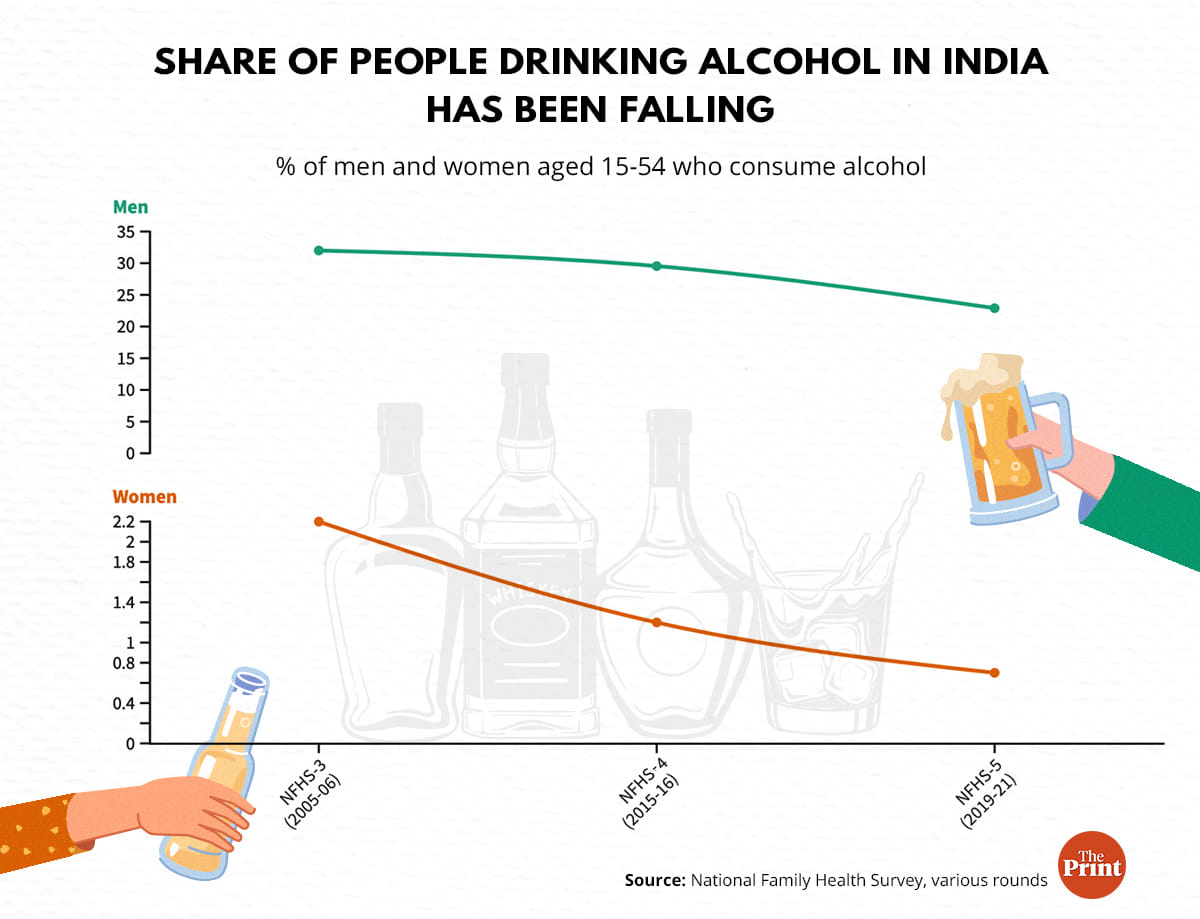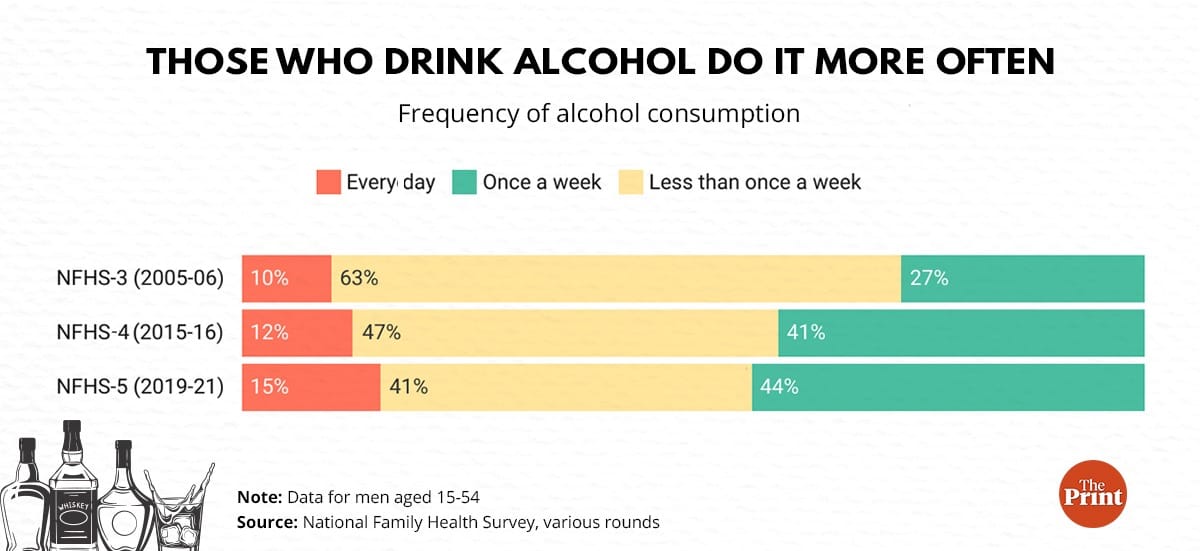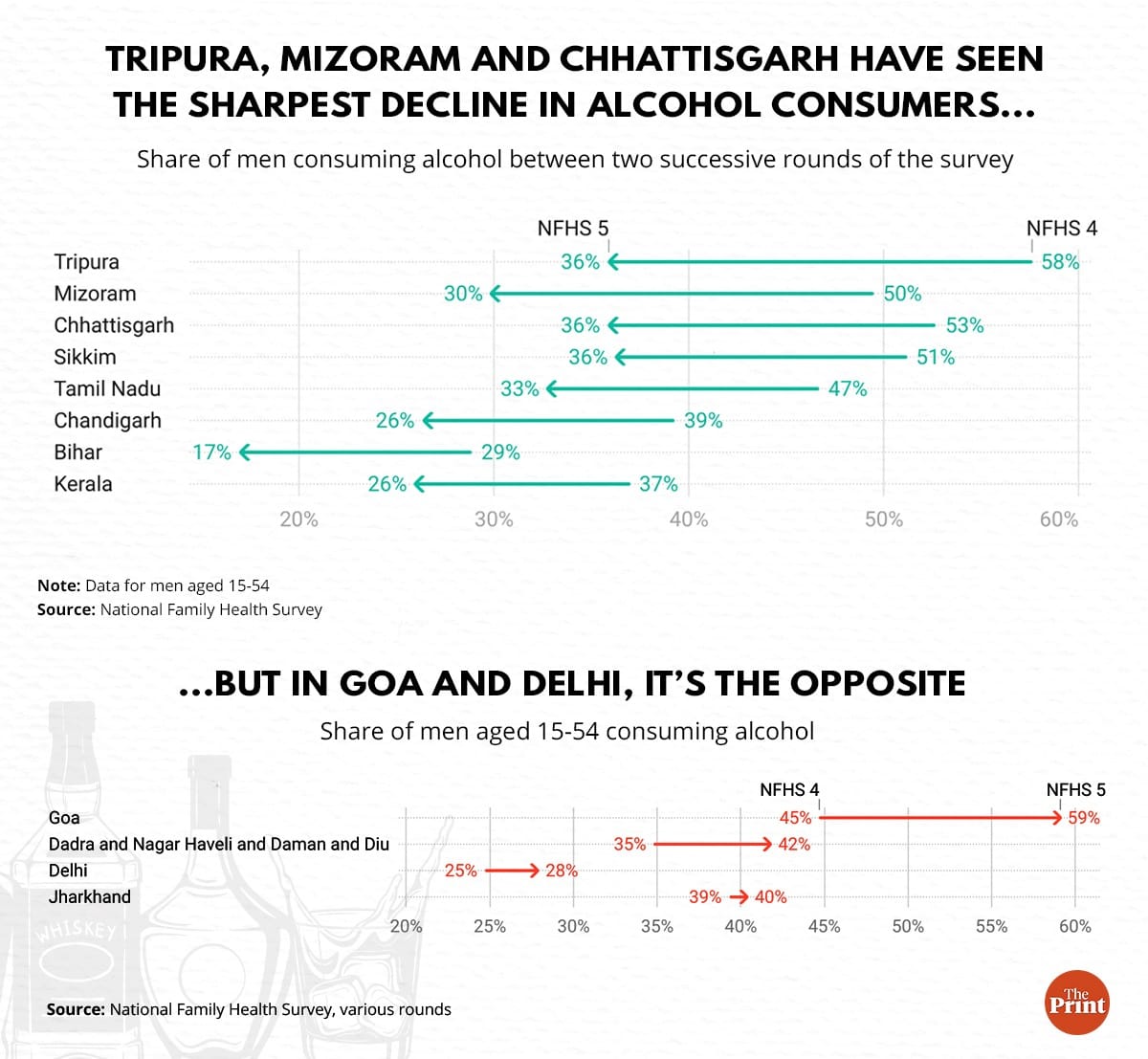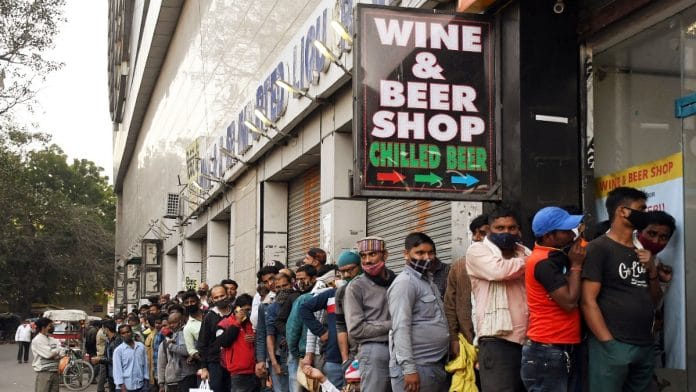New Delhi: Indians aren’t drinking as much liquor as they used to in the first decade of this century, suggest findings of the fifth National Family Health Survey (NFHS-5), conducted between 2019 and 2021.
According to NFHS-5 data, by 2021, only about 22.9 per cent of men and 0.7 per cent of women in India aged between 15 and 54 consumed liquor. This is part of a larger trend seen in NFHS data — that of a consistent decline, between 2006 and now, in the number of Indians who drink.
Between NFHS-3 (2005-06) and NFHS-4 (2015-16), the number of Indian men who drank liquor dipped from 32 per cent to 29 per cent. In the case of women, this number declined from 2.2 per cent to 1.2 per cent.
“The proportion of men who drink alcohol decreased, from 29 per cent to 22 per cent, between NFHS-4 in 2015-16 and NFHS-5 in 2019-21. During that period, the proportion of women who drink remained unchanged,” said the NFHS-5 report, released on 6 May.

However, in contrast to these findings, the Indian Council for Research on International Economic Relations (ICRIER), a Delhi-based policy think tank, in a report published last August had said that India’s liquor industry was worth $52.5 billion and was envisaged to grow by 6.8 per cent year-on-year till 2023.
The NFHS-5 data also doesn’t corroborate the findings of the World Health Organization’s (WHO) 2018 Global Status Report on Alcohol and Health, which estimated a 38 per cent increase in per-capita alcohol consumption among individuals aged 15 years or older in India during the period 2010–2017.
“The survey (NFHS-5) was conducted between 2019 and 2021, which can be considered abnormal years. Hence, wide variations in household interviews are expected. During this time period, we witnessed two significant lockdowns and as a result, the access to alcohol became restricted,” said Monika Arora, director, health promotion division at the Gurugram-based think tank Public Health Foundation of India (PHFI).
The growth of India’s liquor market despite a dip in the number of Indians who drink could also mean that those who do consume liquor are drinking more than they used to, said Yatan Pal Singh Balhara, additional professor of psychiatry at the National Drug Dependence Treatment Centre (NDDTC), AIIMS-Delhi.
Also Read: Shaken, stirred & appreciated — these clubs are making connoisseurs of India’s liquor consumers
Lockdowns caused decline?
Due to the reference period for NFHS-5 and the Covid-19 lockdown, this data isn’t comparable with NFHS-4 data, Arora said, adding, “If there was a fall in liquor consumers in India, that should reflect in the sales, revenue and other market data, but that’s not visible here. In fact, the beer and spirits sales data in India has shown a sharp increase in 2021, and companies even reported higher volumes compared to pre-COVID sales.”
Arora said that there’s also the possibility of respondents not answering questions about liquor consumption sincerely if the collection of data coincided with the lockdown, since alcohol wasn’t being sold at the time and respondents wouldn’t have reported usage had they bought liquor illegally.
“The other reason could also be that this was a temporary behaviour change due to access restrictions and multiple health authorities issuing advisories to stay healthy to avoid severe Covid outcomes during lockdown, but the market recovery reported by alcohol companies in 2021 does not reflect any reduction in alcohol use in India,” she said.
‘Fewer Indians drinking more’
“This means a relatively smaller proportion of the people are consuming a relatively larger volume of alcohol,” said Balhara, referring to the contradiction between market trends and NFHS-5 data. Balhara, with other researchers, had conducted a study on declining liquor consumption in India, relying on statistics available for 16 states.
The NFHS-5 data also shows that while the number of Indians who consume liquor has declined, there has been a significant increase in the frequency of liquor consumption.

In 2005-06, about 10 per cent of Indian men consumed liquor every day. A decade later, this number was 12.4 per cent, and by 2019-21, it had jumped to 15.4 per cent.
There has also been an increase in the number of Indians who drink liquor at least once a week — from 26.9 per cent in 2005-06 to 43.5 per cent in 2019-21. Concurrently, the number of men who drink liquor less than once a week has declined from 63 per cent in 2005-06 to 41 per cent in 2019-21.
Goa sees steepest rise in liquor consumption
Tripura recorded the steepest fall in consumption of liquor among men aged 15-49 — from 57.6 per cent in 2015-16 to 35.9 per cent in 2019-21, which is still well above the national average of 22.9 per cent.
Liquor consumption among men declined by over 10 per cent in at least seven states/ Union territories: Mizoram, Chhattisgarh, Sikkim, Tamil Nadu, Chandigarh, Bihar, and Kerala.
However, four Indian states/ UTs recorded an increase in the number of men who admitted to drinking liquor.
In Goa, 59.1 per cent of men said they consumed liquor in 2019-21, a jump from 44.7 per cent in 2015-16 — the steepest rise in any state. Not far behind is the Union territory of Daman and Diu and Dadra and Nagar Haveli, where the number of men who said they drink liquor jumped to 41.8 per cent in 2019-21, from 34.8 per cent in 2015-16.

Delhi and Jharkhand also recorded a marginal increase in the number of men who said they consumed liquor.
In India, women have always accounted for a minute fraction of liquor consumers. This is one reason any significant change in the trend of liquor consumption among men is more likely to impact the national averages.
“Drinking alcohol is more common among women from Scheduled Tribes (4 per cent) than from any other caste/ tribe group. Drinking is most common among Christian men (36 per cent) and men belonging to “other” religions (49 per cent), men with less than five years of schooling (33 per cent), men from Scheduled Tribes (34 per cent), and men aged 35-49 (30 per cent),” said the NFHS-5 report.
While admitting that the change in liquor consumption trends is significant, Balhara believes there is a need for deeper examination of the factors influencing this change.
“The NFHS does not explore the reasons behind alcohol use and hence, does not comment on the same. Unfortunately, there is no other survey in India that has used a consistent methodology so that we can even draw conclusions on the change. The reasons for change remain completely unexplored,” he told ThePrint.
(Edited by Amrtansh Arora)
Also Read: Ask consumers to be informers, go after suppliers: Bihar’s new plan to implement prohibition






